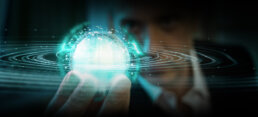HOW WE THINK
Perception's Science Fiction Thinkingis not a replacement for traditional Design Thinking, but its evolution, an imaginative yet structured framework for driving digital transformation. The process begins with Perceive + Define, where teams immerse themselves in story-driven discovery to uncover the deeper motivations, emotions, and use cases that shape user needs. With clarity established, Imagine & Envision suspends constraints to explore bold, cinematic possibilities, using sketches, curated imagery, and narrative storytelling to bring potential futures into vivid focus.
Those speculative visions move into Build & Create, where tangible prototypes transform concepts into experiential realities, testing feasibility and inspiring new insights. The journey culminates in Inspire & Believe, where ideas are rendered so authentic and immersive that stakeholders can feel their future potential. These prototypes act as catalysts—aligning vision, energizing engineering, and anchoring long-term roadmaps. Through continuous iteration and feedback, Science Fiction Thinking doesn’t just design products, it forges powerful “north stars” that expand imagination, eliminate weak paths, and illuminate transformative futures.
